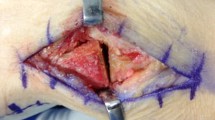Abstract
Background
When performing hindfoot arthodeses, one goal of fixation is often to achieve compression across the joint. Traditional lag screws are applied eccentrically, providing compression more on the edge of the fusion. A new technique, using a post in one bone and a lag screw through the post to the other bone, may offer better compression across more of the joint.
Methods
There are three parts to this study comparing a post-and-screw construct to traditional lag screws. Synthetic bone models, representative of the talonavicular joint, were created and assessed for biomechanical measures of compression. Next, the post-and-screw construct was tested in cadavers, under conditions representing early weight bearing after arthrodesis surgery. Finally, 18 patients who had a talonavicular fusion with a post-and-screw construct with one surgeon were compared to the previous 18 patients fixed with traditional screws.
Results
In the synthetic bone model, the post-and-screw construct brought the centre of compression closer to the centre of the joint, suggesting compression was less eccentric. Neither traditional screws nor the post-and-screw construct were sufficiently strong to resist early weight bearing forces in cadaver specimens. In the clinical comparison, four patients had a painful nonunion when fixed with traditional screws, compared to none in the post-and-screw construct.
Conclusions
A post-and-screw construct spreads the forces of compression more uniformly across an arthrodesis, even when placed eccentrically. Although not all the biomechanical measures were superior, the post-and-screw construct achieved higher levels of successful fusion in patients. This technology may offer improved outcomes in some clinical scenarios and deserves further study.
Level of Evidence: Level 3





Similar content being viewed by others
References
Bennett GL, Graham CE, Mauldin DM (1991) Triple arthrodesis in adults. Foot Ankle 12(3):138–143
Chen CH, Huang PJ, Chen TB, Cheng YM, Lin SY, Chiang HC, Chen LC (2001) Isolated talonavicular arthrodesis for talonavicular arthritis. Foot Ankle Int 22(8):633–636
Ljung P, Kaij J, Knutson K, Pettersson H, Rydholm U (1992) Talonavicular arthrodesis in the rheumatoid foot. Foot Ankle 13(6):313–316
Bonnel F, Teissier P, Maestro M, Ferré B, Toullec E, AFCP (2011) Biometry of bone components in the talonavicular joint: a cadaver study. Orthop Traumatol Surg Res 97(6 Suppl):S66–S73. doi:10.1016/j.otsr.2011.06.005
Goldstein SA (1987) The mechanical properties of trabecular bone: dependence on anatomic location and function. J Biomech 20(11–12):1055–1061
Jarrell SE 3rd, Owen JR, Wayne JS, Adelaar RS (2009) Biomechanical comparison of screw versus plate/screw construct for talonavicular fusion. Foot Ankle Int 30(2):150–156. doi:10.3113/FAI.2009.0150
Moore BE, Wingert NC, Irgit KS, Gaffney CJ, Cush GJ (2014) Single-incision lateral approach for triple arthrodesis. Foot Ankle Int 35(9):896–902. doi:10.1177/1071100714539658
DiGiovanni CW, Lin SS, Baumhauer JF, Daniels T, Younger A, Glazebrook M, Anderson J, Anderson R, Evangelista P, Lynch SE, North American Orthopedic Foot and Ankle Study Group (2013) Recombinant human platelet-derived growth factor-BB and beta-tricalcium phosphate (rhPDGF-BB/β-TCP): an alternative to autogenous bone graft. J Bone Joint Surg Am 95(13):1184–1192. doi:10.2106/JBJS.K.01422
McKeon KE, McCormick JJ, Johnson JE, Klein SE (2012) Intraosseous and extraosseous arterial anatomy of the adult navicular. Foot Ankle Int 33(10):857–861. doi:10.3113/FAI.2012.0857
Glazebrook M, Beasley W, Daniels T, Evangelista PT, Donahue R, Younger A, Pinzur MS, Baumhauer JF, DiGiovanni CW (2013) Establishing the relationship between clinical outcome and extent of osseous bridging between computed tomography assessment in isolated hindfoot and ankle fusions. Foot Ankle Int 34(12):1612–1618. doi:10.1177/1071100713504746
Author information
Authors and Affiliations
Corresponding author
Rights and permissions
About this article
Cite this article
Greisberg, J., Vosseller, J.T., Ferry, C. et al. A new method for achieving compression in hindfoot arthrodesis. International Orthopaedics (SICOT) 39, 2267–2274 (2015). https://doi.org/10.1007/s00264-015-2855-y
Received:
Accepted:
Published:
Issue Date:
DOI: https://doi.org/10.1007/s00264-015-2855-y




